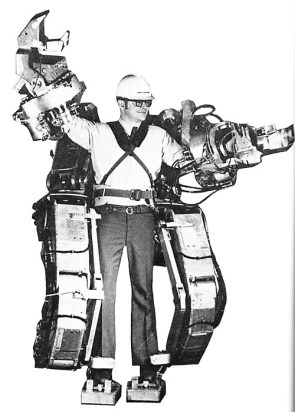Every technological advancement seems to have a sharp inflection point, a time before which it seems like any early adopters are considered kooks, but beyond which the device or service quickly becomes so mainstream that non-adopters become the kooky ones. Take cell phones, for example – I clearly remember a news report back in the 1990s about some manufacturers crazy idea to put a digital camera in a phone. Seemingly minutes later, you couldn’t buy a phone without a camera.
It seems like we may be nearing a similar inflection point with a technology far more complex and potentially far more life-altering than cameras in cell phones: powered exoskeletons. With increasing numbers of news stories covering advancements in exoskeletal assistants for the elderly, therapeutic applications for those suffering from spinal cord injuries and neurodegenerative diseases, and penetration into the workplace – including the battlefield – as amplifiers of human effort, it’s worth taking a look at where we are with exoskeletons before seeing someone using one in public becomes so commonplace as to go unnoticed.
History
First, some definitions. I’m using the term “exoskeleton” in perhaps an overly broad way, referring to just about any powered, articulated device that’s human-wearable and intended to either enhance or restore the natural range of human motion. I’m also including some of the non-powered worker assist devices currently on the market, as they’re an important category and most of them could serve as the foundation for powered appliances in the near future. But I’ve left out mechas or mech-suits; as cool as it may be to watch Jaegers and kaiju duke it out in Pacific Rim, that opens up a can of worms.
The concept of a powered exoskeleton goes back quite a way, to a steam-powered time long before the idea was practical. It would not be until the 1960s, when control systems and power transmission had become sufficiently advanced, that a serious effort would be made to develop an exoskeleton. That came from the R&D labs of General Electric in the form of an electromechanical suit called the Hardiman. The device had four hydraulically powered limbs that were supposed to sense the operator’s movements within them and smoothly reproduce them in each limb, allowing the operator to lift a load equivalent to the 1500 pound (680 kg) weight of the suit. But the control systems could never be adjusted sufficiently to reduce the tendency of the limbs to move violently; consequently, nobody ever donned the suit while it was powered up.
Perhaps the first exoskeleton that made waves in the media was the LIFESUIT, designed by Monty Reed, a former US Army Ranger. When a night parachute jump went horribly wrong with 100 feet (33 meters) left to go before the ground, Monty suffered injuries that would severely hamper his mobility. While not paralyzed, he was unable to walk or stand for more than a few …read more
Source:: Hackaday

